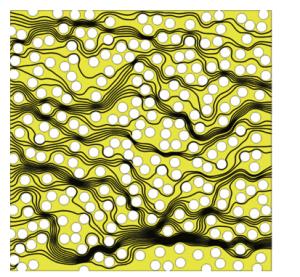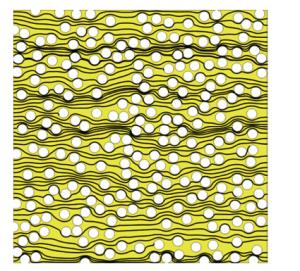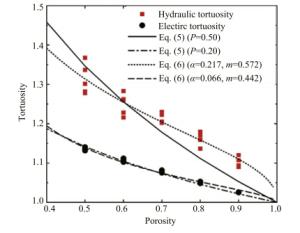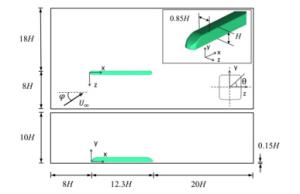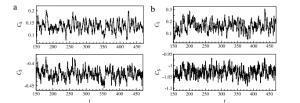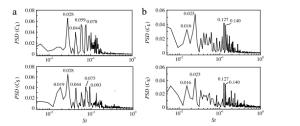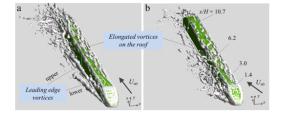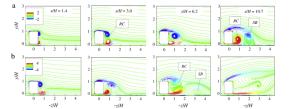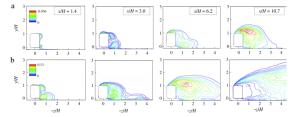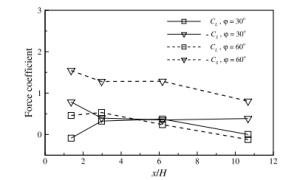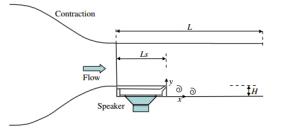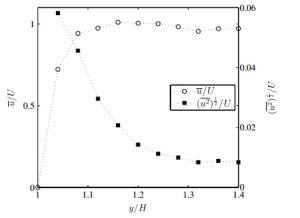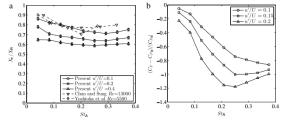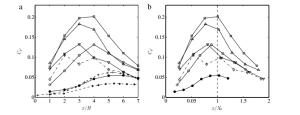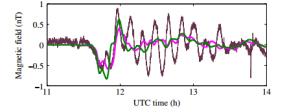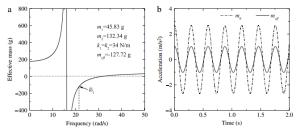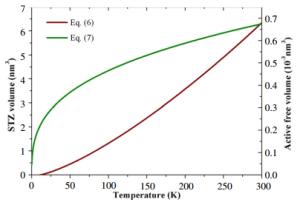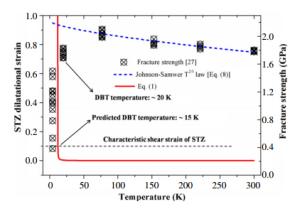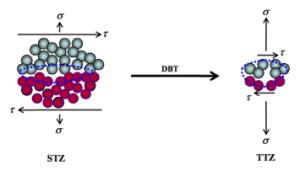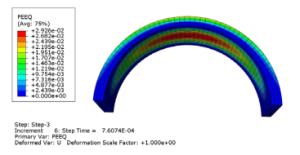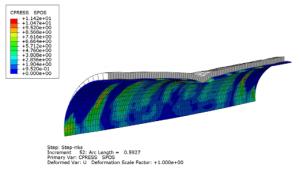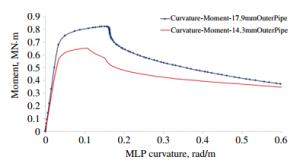Institute of Mechanics,
Chinese Academy of Sciences
2015 Vol.5(5)
Display Mode: |
Theoretical and Applied Mechanics Letters 2015, 5(5): 177-180.
doi: 10.1016/j.taml.2015.07.001
Abstract:
Tortuosity is one of the key parameters to characterize the transport properties of porous media. There are many models for tortuosity estimation based on some definitions: geometric, hydraulic, electric, and diffusive definitions. However, relationships among those tortuosities remain unclear due to the lack of direct comparison on the same porous media. Here we focus on hydraulic and electric tortuosities and have conducted a series of finite element simulations with the Navier-Stokes equation and the equation for electric current to directly compare tortuosities. The results revealed that: (1) on average, hydraulic tortuosity is 15% greater than that of the electric one; (2) the proposed model based on the van Genuchten-type function successfully approximates both hydraulic and electric tortuosities; (3) tortuosities obtained from the porous media packed with circular particles and square particles show quantitatively similar trends.
Tortuosity is one of the key parameters to characterize the transport properties of porous media. There are many models for tortuosity estimation based on some definitions: geometric, hydraulic, electric, and diffusive definitions. However, relationships among those tortuosities remain unclear due to the lack of direct comparison on the same porous media. Here we focus on hydraulic and electric tortuosities and have conducted a series of finite element simulations with the Navier-Stokes equation and the equation for electric current to directly compare tortuosities. The results revealed that: (1) on average, hydraulic tortuosity is 15% greater than that of the electric one; (2) the proposed model based on the van Genuchten-type function successfully approximates both hydraulic and electric tortuosities; (3) tortuosities obtained from the porous media packed with circular particles and square particles show quantitatively similar trends.
Theoretical and Applied Mechanics Letters 2015, 5(5): 181-186.
doi: 10.1016/j.taml.2015.06.001
Abstract:
The yaw effect of the side flow around a high-speed train is studied by means of large eddy simulation at two typical yaw angles of φ = 30° and 60°, respectively. Both the mean and fluctuating values of lift force and side force coefficients increase obviously as the yaw angle increases. The spectral analysis indicates that the time-dependent aerodynamic forces are dominated by several energetic frequencies and the frequency range is broadened to a higher extent for the large yaw angle. To have a better understanding of the train aerodynamic behaviors, the dedicate three-dimensional vortical structures are analyzed for the flow at the two yaw angles. Moreover, the time-averaged flow patterns, turbulent statistics, and the surface forces are also studied on sectional planes along the train.
The yaw effect of the side flow around a high-speed train is studied by means of large eddy simulation at two typical yaw angles of φ = 30° and 60°, respectively. Both the mean and fluctuating values of lift force and side force coefficients increase obviously as the yaw angle increases. The spectral analysis indicates that the time-dependent aerodynamic forces are dominated by several energetic frequencies and the frequency range is broadened to a higher extent for the large yaw angle. To have a better understanding of the train aerodynamic behaviors, the dedicate three-dimensional vortical structures are analyzed for the flow at the two yaw angles. Moreover, the time-averaged flow patterns, turbulent statistics, and the surface forces are also studied on sectional planes along the train.
Theoretical and Applied Mechanics Letters 2015, 5(5): 191-195.
doi: 10.1016/j.taml.2015.08.002
Abstract:
The flow structures in a separated shear layer actuated by a synthetic jet actuator were studied using experimental methods. When forced at a frequency much lower than the natural shedding frequency (fH/U = 0.042 or fXr/U = 0.24), the vertical flapping motion of the shear layer downstream of the separation point became prominent. The size of the peak in the pressure spectra at the forcing frequency (StA = fAH/U) measured near the separation point (x/H = 1) increased linearly with the forcing amplitude (u'/U) suggesting a linear response of the pressure fluctuations to the forcing by the synthetic jet. The linear response did not hold for the pressure fluctuations away from the jet exit as the magnitude of the peak for StA measured at x/H = 3 soon saturated when the forcing amplitude became larger than 0.3.
The flow structures in a separated shear layer actuated by a synthetic jet actuator were studied using experimental methods. When forced at a frequency much lower than the natural shedding frequency (fH/U = 0.042 or fXr/U = 0.24), the vertical flapping motion of the shear layer downstream of the separation point became prominent. The size of the peak in the pressure spectra at the forcing frequency (StA = fAH/U) measured near the separation point (x/H = 1) increased linearly with the forcing amplitude (u'/U) suggesting a linear response of the pressure fluctuations to the forcing by the synthetic jet. The linear response did not hold for the pressure fluctuations away from the jet exit as the magnitude of the peak for StA measured at x/H = 3 soon saturated when the forcing amplitude became larger than 0.3.
Theoretical and Applied Mechanics Letters 2015, 5(5): 187-190.
doi: 10.1016/j.taml.2015.08.001
Abstract:
A magnetic anomaly was recorded at Easter Island on 27 February 2010 during the Chile tsunami event. The physics of the magnetic anomaly is analyzed using kinematic dynamo theory. Using a single wave model, the space and time behavior of the magnetic field is given. By joint analysis of the magnetic observations, tide gauge data and numerical results of the global tsunami propagation, we show the close resemblance between the predicted spatial and temporal magnetic distributions and the field data, indicating the magnetic anomaly at Easter Island was actually induced by the motion of seawater under tsunami waves. Similarity between the field magnetic data at Easter Island during 2010 Chile tsunami and sea surface level is verified with realistic tsunami propagating model.
A magnetic anomaly was recorded at Easter Island on 27 February 2010 during the Chile tsunami event. The physics of the magnetic anomaly is analyzed using kinematic dynamo theory. Using a single wave model, the space and time behavior of the magnetic field is given. By joint analysis of the magnetic observations, tide gauge data and numerical results of the global tsunami propagation, we show the close resemblance between the predicted spatial and temporal magnetic distributions and the field data, indicating the magnetic anomaly at Easter Island was actually induced by the motion of seawater under tsunami waves. Similarity between the field magnetic data at Easter Island during 2010 Chile tsunami and sea surface level is verified with realistic tsunami propagating model.
Theoretical and Applied Mechanics Letters 2015, 5(5): 196-199.
doi: 10.1016/j.taml.2015.08.003
Abstract:
We investigate the interaction between a positive mass and a negative effective mass through a threemass chain connected with elastic springs, a pair of masses is designed to have an effective negative mass, and it interacts with the third positive one as if an equivalent two-mass chain. The dynamics of the equivalent two-mass chain shows that the two bodies may be self-accelerated in same direction when the effective mass becomes negative, the experiment is also conducted to demonstrate this type of motion. Wefurther show that the energy principle (Hamilton's principle) is applicable if the energy of the negative mass unit is properly characterized. The result may be relevant to composite with cells of effective negative mass, their interaction with matrix may lead to more richer unexpected macroscopic responses.
We investigate the interaction between a positive mass and a negative effective mass through a threemass chain connected with elastic springs, a pair of masses is designed to have an effective negative mass, and it interacts with the third positive one as if an equivalent two-mass chain. The dynamics of the equivalent two-mass chain shows that the two bodies may be self-accelerated in same direction when the effective mass becomes negative, the experiment is also conducted to demonstrate this type of motion. Wefurther show that the energy principle (Hamilton's principle) is applicable if the energy of the negative mass unit is properly characterized. The result may be relevant to composite with cells of effective negative mass, their interaction with matrix may lead to more richer unexpected macroscopic responses.
Theoretical and Applied Mechanics Letters 2015, 5(5): 200-204.
doi: 10.1016/j.taml.2015.09.002
Abstract:
A theoretical model that takes into account the free-volume aided cooperative shearing of shear transformation zones (STZs) is developed to quantitatively understand the ductile-to-brittle transition (DBT) of metallic glasses. The STZ dilatational strain is defined as the ratio of STZ-activated free volume to STZ volume itself. The model demonstrates that the STZ dilatational strain will increase drastically and exceed the characteristic shear strain of STZ as temperature decreases below a critical value. This critical temperature is in good agreement with the experimentally measured DBT temperature. Our results suggest that the DBT of metallic glasses is underpinned by the transition of atomic-cluster motions from STZ-type rearrangements to dilatational processes (termed tension transformation zones (TTZs)).
A theoretical model that takes into account the free-volume aided cooperative shearing of shear transformation zones (STZs) is developed to quantitatively understand the ductile-to-brittle transition (DBT) of metallic glasses. The STZ dilatational strain is defined as the ratio of STZ-activated free volume to STZ volume itself. The model demonstrates that the STZ dilatational strain will increase drastically and exceed the characteristic shear strain of STZ as temperature decreases below a critical value. This critical temperature is in good agreement with the experimentally measured DBT temperature. Our results suggest that the DBT of metallic glasses is underpinned by the transition of atomic-cluster motions from STZ-type rearrangements to dilatational processes (termed tension transformation zones (TTZs)).
Theoretical and Applied Mechanics Letters 2015, 5(5): 205-209.
doi: 10.1016/j.taml.2015.08.004
Abstract:
The structural behavior of mechanically lined pipes (MLPs) during the spooling-on phase is investigated in this paper, motivated by their promising offshore applications relying on reel installation. By applying quasi 2D models, we first investigated the gripping stresses preserved in the MLP after the hydraulic expansion manufacturing process and the detachment of the liner under spooling-on curvatures. Furthermore, a comparative 3D finite element (FE) analysis for the liner wrinkling behaviors of MLP with different wall thicknesses of outer layers was performed and indicated that when the wall thickness of outer layer increases from 14.3mmto 17.9 mm, MLP's critical spooling-on curvature increased more than 47%, reaching 0.1432 rad/m.
The structural behavior of mechanically lined pipes (MLPs) during the spooling-on phase is investigated in this paper, motivated by their promising offshore applications relying on reel installation. By applying quasi 2D models, we first investigated the gripping stresses preserved in the MLP after the hydraulic expansion manufacturing process and the detachment of the liner under spooling-on curvatures. Furthermore, a comparative 3D finite element (FE) analysis for the liner wrinkling behaviors of MLP with different wall thicknesses of outer layers was performed and indicated that when the wall thickness of outer layer increases from 14.3mmto 17.9 mm, MLP's critical spooling-on curvature increased more than 47%, reaching 0.1432 rad/m.
 Submit a Paper
Submit a Paper
 Subscription
Subscription
News
MORE+
Call for Papers
MORE+
- Crossing-Mechanics Driven by Big Data
- Machine learning in the fluid mechanics research of wind energy
- Mechanics of Origami/Kirigami structures and metamaterials
- New insights and perspectives on impact biomechanics for human tissues: from injury prevention, protection to protective equipment
- Environmental Mechanics for Extreme Natural Events




